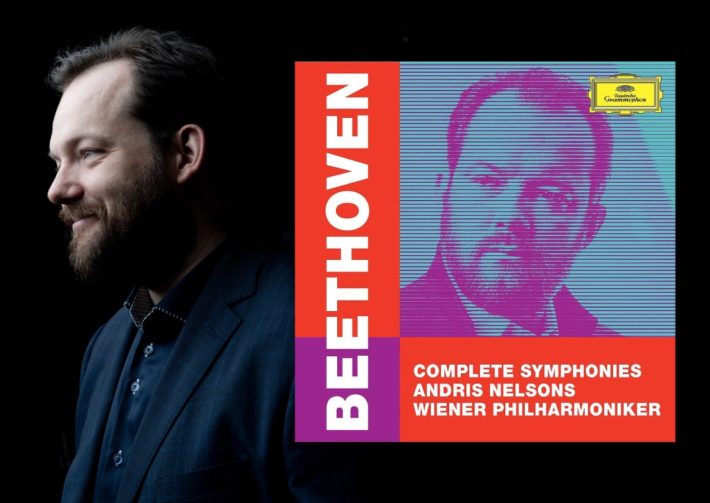Image: ©️ Marco Borggreve
There are close to 200 full cycles Beethoven’s nine Symphonies, performed by practically all respected orchestras and conductors. On the yellow label alone, the Vienna Philharmonic Orchestra has few notable cycles: Bohm, Bernstein, Abbado (in his early, often overlooked cycle) and Thielemann. There’s also Rattle’s digital cycle on Warner (originally EMI), not to mention many single Symphonies recordings. In other words, 250 celebrations or not, Nelsons is entering a crowded field, including cycles by the orchestra he chose for this recording.
When conducting the VPO, there is obviously a great tradition of sound and approach to the music, and here you can rest a sure that this orchestra’s famous sound quality is alive and well, superbly recorded too. The question that keeps nagging while listening to this set is whether a conductor, any conductor, should let the VPO play as they will or try and inject his or her own interpretation of the music. In most of the performances we have here, Nelsons chooses not to interfere, and it’s not necessarily a bad thing.
When it works, there is really no need for obstructive decisions, as in a truly wonderful performance of the Sixth Symphony (“Pastoral”), where the velvety sound of the Vienna Philharmonic’s strings is in full display, or in the effortless fast runs of the woodwinds in the final movement of the Fourth Symphony. There are places, though, that one feels a little intervention might have been helpful, even as a discrete way of elevating the music. Unfortunately, this thought presents itself with two of the best-known Symphonies – No. 3 (“Eroica”) and No 5. The first movement of the Eroica is somewhat tamed, and although nelsons follows the score closely, the music feels lacking in energy. The syncopated chords that precede the celebratory display of the main theme can be observed quietly (as requested by the composer), but without losing tension, as Rattle showed in his version. Here, the hushed playing by the strings, lovely as it is, makes any tension disappear rapidly.
On the other spectrum, Nelsons and the VPO have a tendency to over-emphasis climaxes, getting back to old mono recordings by Klemperer or Furtwängler, but without the strategic thinking of the great masters. And so, in the first movement of the Eroica, the painful dissonant chords, which finally introduces the late second theme, make it sound deflated. This also happens in the leading up to the recapitulation (11’00” onward), and at the end of the Funeral March’s high point (9’45”). And why do the horns suddenly slow down in the trio section of the Scherzo? A moment that should be witty turns into something heavy-handed.
In the Fifth Symphony, any sense of revolution is lost, the orchestra plays without any excitement, again reminiscent of the old-days performances but without the inner tension that compensated for lack of textural lightness. The third movement, so thrilling in Bernstein’s and Rattle’s versions, is dully performed, and the finale is celebratory but lacks drive.
Things get much better with the Seventh and Eighth Symphonies. On both works, the Vienna Philharmonic sounds much more spontaneous, sometimes at the expense of their usual accuracy (the third movement of the Seventh Symphony is too fast even for a Presto). In the first movement of this Symphony, there is no match to the superb handling of the transitions as in Carlos Kleiber’s legendary version, but this is a nice Seventh nonetheless.
Contrary to Rattle, and on par with Thielemann, it doesn’t sound as if Nelsons shrinks the size of the orchestra in the first two Symphonies. The first, as a whole, sounds somewhat hesitant, but the Second Symphony is nicely done, if one ignores the tendency to give too much weight as a device to make a musical point.
The Ninth Symphony, a piece that should and can be a triumphant ending to a Beethoven Symphonies cycle, is anything but here. It’s not the first movement, which is rather predictable, nor the slow movement which, again, finds Nelsons letting the wonderful string players present their greatest asset. It’s the finale, a belligerent affair that finds the Wiener Singverein having trouble in loud or high passages, and a group of soloists that vibrate to such an extent that one can’t distinguish the main melody.
When conductors with big personalities partner with the Vienna Philharmonic, the results can be electrifying (Bernstein, Rattle) or more tamed (Bohm, Abbado and Thielemann). Here we find a middle of the road approach. It can have fine results indeed, as in the Second, Fourth, Sixth, Seven and Eight Symphonies. With a state of the art sound and luxurious packaging and documentation, this may be a decent purchase and a good listen, but not one of the top cycles from the nearly 200 alternatives.

Beethoven – Symphonies No. 1-9 (Complete)
Camilla Nylund – Soprano
Gerhild Romberger – Mezzo
Klaus Florian Vogt – Tenor
Georg Zeppenfeld – Bass
Wiener Singverein
Vienna Philharmonic Orchestra
Andris Nelsons – Conductor
Deutsche Grammophon, CD 28948370719
Albums Mentioned In This Review
Follow Us and Comment:
Get our periodic classical music newsletter with our recent reviews, news and beginners guides.
We respect your privacy.









